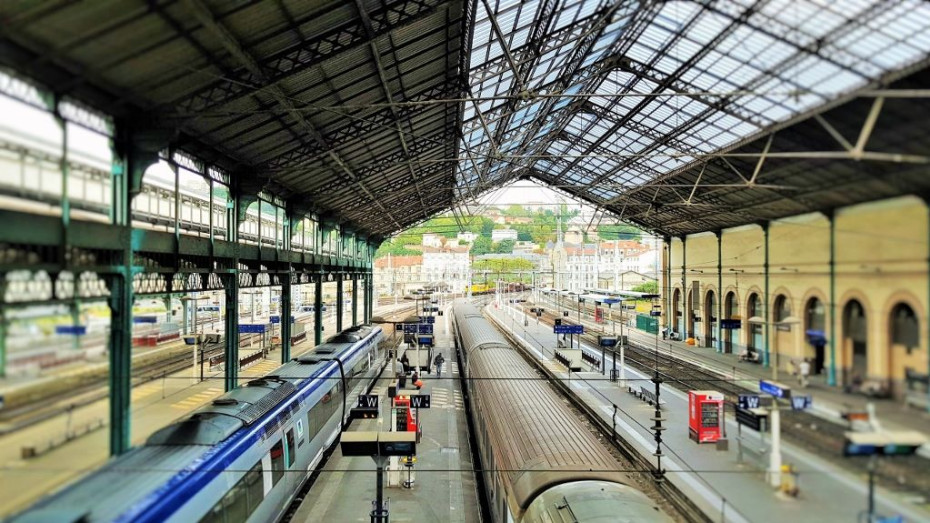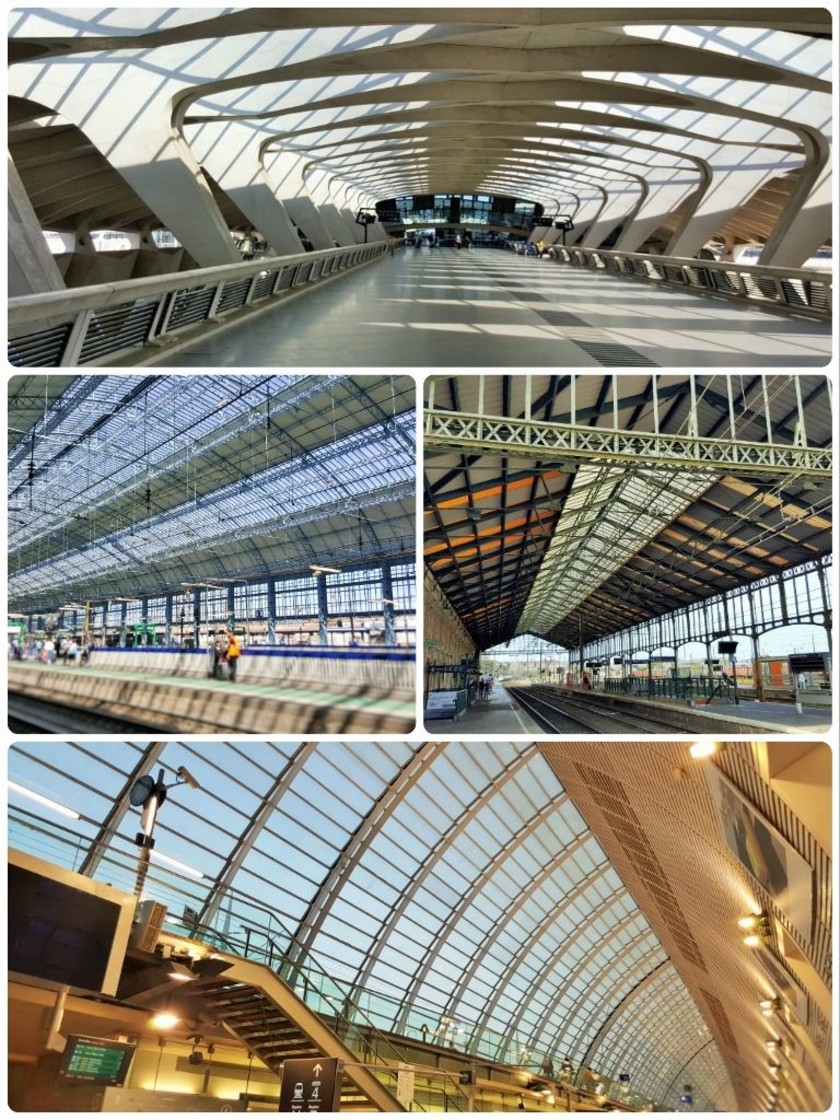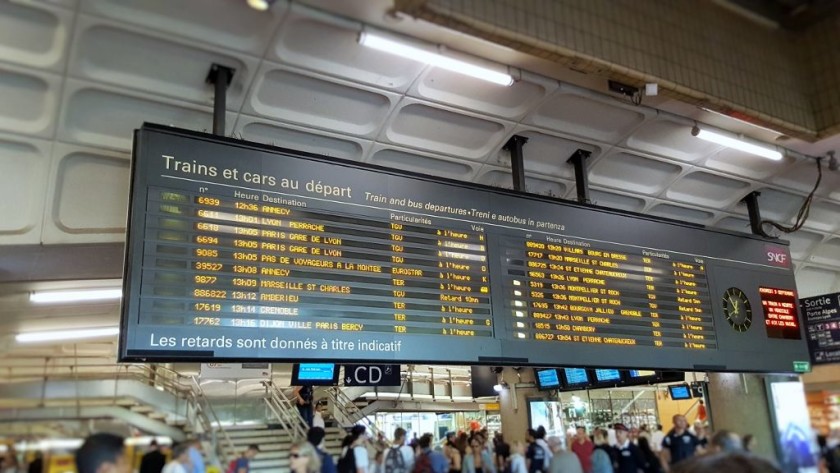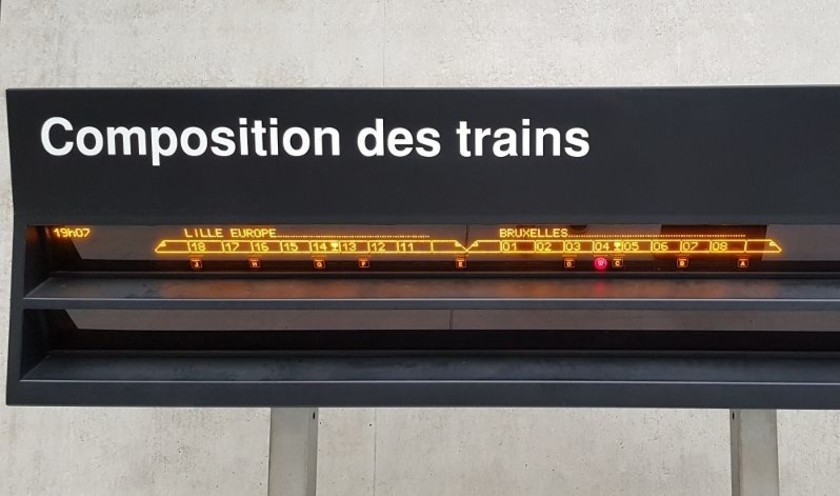Related Content
Content

Using the main railway stations in France
Includes insights to buying tickets and how to use the departure information to find your train.
Share
Our guide to taking a train from major French train stations aims to remove much of the confusion you may experience when making your way to your train, or buying tickets at the station.
The stations used by express trains in France are often beautifully preserved examples of 19th century and early 20th century architecture, but some of them have yet to be fully modernised to meet the needs of 21st century travellers.

8 Things Worth Knowing about major stations in France:


(1) The number or letter of the specific voie (platform/track) that a train will be departing from, is typically confirmed around 20 minutes before the departure time; it may only be confirmed only 5 minutes in advance.
Though when travelling on Ouigo services the departure details are typically confirmed at least 30 mins in advance.
(2) The terms and conditions of French train tickets typically stipulate that you must be on the platform at least 2mins before the departure of your train; the rule when travelling on Ouigo services is 5 mins before departure.
(3) ALL tickets issued by the ticket machines or at ticket counters must be stamped in the yellow boxes prior to boarding a train.
There is no need to stamp any other type of ticket.
Normally these ticket stamping machines can be found at the entrance to a voie/track/platform.
(4) The voies (platforms/tracks) will be divided into repéres (zones) indicated by letters.
(5) At some stations, letters and not numbers are used to indicate the specific voie (platform/track); and when that is the case the repéres (zones) letters are larger, and generally more prominent, than the voie letter.
(6) At the majority of non-terminal stations - those that don't have large concourses at one end of the voies (platforms/tracks) - the access to most of the train departures is by passages under the railway lines.
These passages link the entrances and station buildings to the voies (platforms/tracks) that the trains depart from.
(7) At some very busy stations non-terminal stations including Bordeaux-St Jean, Dijon-Ville and Toulouse-Matabiau, not all of the voies (platforms/tracks) have elevator access.
When they are available the use of the elevators is typically restricted to travellers who require special assistance and can't use the stairs.
So when arriving and departing by trains you may no choice but to heave luggage etc up or down staircases, because escalator access to the voies (platforms/tracks) tends to be very much the exception rather than the norm.
(8) French stations rarely have cash machines/dispensers, so the best option is to try and find a bank near the station. Don't plan on being able to obtain cash on arrival at a station.
Left luggage
Only the following stations have automatic left luggage facilities (lockers or their equivalent) managed by SNCF, within the station
- Paris Gare du Nord
- Paris Gare de l'Est
- Paris Gare de Lyon
- Paris Montparnasse
- [Paris Austerlitz]/train-travel-info/countries/france/cities/paris/rail-stations/paris-austerlitz/)
- Bordeaux St Jean
- Lyon Part Dieu
- Marne la Vallée Chessy
- Marseille St Charles
- Montpellier St Roch
- Strasbourg
These stations have staffed left luggage facilities:
Bags can be left in these facilities for a maximum of 3 days, with payment required for each 24hr period.
Many stations now also have independent left luggage facilities managed by specialist companies in their neighborhoods.
Buying and Collecting tickets:


SNCF is rolling out new ticket machines across French stations, they’re worth trying before joining the queue at ticket/billetterie desks.
If when booking you opted to collect E- tickets at the station and will be picking up the tickets on your travel date, they can be collected from these machines.
You will need to enter your named and the order number
Stations tend to have either the yellow machines OR the white machines, but 'Grandes Lignes' (TGV or IC tickets) can also be bought and collected from the yellow machines.
We have found the yellow machines easier to use, as the screens on the white machines are not fully translated.
If you have any problems go to the staffed ticket counter
At a few large stations the ticket office (Billetterie) will be separated into two offices, one for tickets for that day’s travel and one for advance tickets/reservations.
The Accueil (information) desks don’t sell tickets, but the staff can point you in the right direction, the staff will likely speak English at the larger stations and in the main tourist areas
Using the train departure information:
At major stations in France there are UP to FIVE types of departure information screens:

(1) Large (usually black) departure screens located on the walls of the main concourse/departure halls.

(2) TV style screens that are scattered around the station - blue for departures and green for arrivals.
At the main Paris stations, the long distance (TGV and IC) trains can shown on a separate screen (s) marked ‘Grande Lignes’.
So if you’re not looking at a ‘Grande Lignes’ screen, you won’t see your train listed if you are taking an IC or TGV train.
At some stations, these blue TV screens indicate in which departure hall at a station you should wait in, prior to the confirmation of the specific voie (platform/track) that your train will be departing from. ~
These blue TV style screens will also show all of the calling points for the next two departures, but only the departure time, train number and final destination is shown for all subsequent departures.

(3) The specific TV screens on each voie (platform/track) which give details of the next departure from that particular voie, including all the stations that a train will be calling at.
If you will be taking a TGV train, or an IC train, which has compulsory reservation, this screen will also show you in which zone/repére each coach of a train will be located.
On the image above the train will be occupying zones/répéres V to Y, coach numbers 1 and 2 will be located in zone/répére Y etc.

(4) You may also see rectangular black ‘composition de train’ indicators, that also show in which zone/repére each coach will be located.
The red light beneath the train indicates the location of the specific indicator you're looking at - in other words, your location on the voie (platform/track).
(5) On each voie (platform/track) there MAY be other screens showing the subsequent departures; the departure times, train numbers and final destinations will be listed.
If you will be changing trains, don't exit the voie (platform/track) before checking these screens.
If you're in luck you may be able to remain on the same voie (platform/track), that you have just arrived at.
Also worth knowing:
French stations generally don’t tend to have paper departure sheets, you have to rely on the electronic departure information screens.
If you want to check the details of a later departure, then small paper timetable booklets are USUALLY available for each train route and these can be found in ticket offices.
Or make enquiries at the information (Accueil) desks.
Making your way to the train:
If you will be travelling by TGV, or an Intercités train with compulsory reservations, the usual FOUR steps to take are:
(1) Check the train number and departure time on your ticket
The train number is not the departure time.
In France each individual departure is given a 4 digit number, which can used to identify each specific train.
(2) At major stations, the main (black) electronic information displays on station concourses and in departure halls, will generally only indicate the terminus station and this train number; and not the other stations that the train will be calling at.
If you can’t see the station you're heading to on these screens, match the train number and departure time on your ticket(s) to the corresponding information on the departure screens.
(3) When the number OR letter of the specific voie (platform/track) that your train will be departing from is displayed make your way to it; keep an eye on the screens, usually the departures details aren't announced - and if they are, it will be only be made in French.
If you collected your ticket from a machine or booking office, don’t forget to stamp your ticket in one of the yellow validation machines.
If you will be boarding a TGV at a terminal station, be aware that some TGV departures can be up to 20 coaches long, so allow time to walk along the voie (platform/track) to find the coach/voiture, in which your reserved seat is located.
Two TGV trains will often be joined together, so if you don’t have time to locate your specific coach/voiture, you at least need to be sure that you will be boarding the correct part of the train.
(4) If you will NOT be boarding a train at a terminus station and have a seat specific ticket/reservation, check the ‘voiture’ (coach) number on your ticket and use the zone information on the voie (platform/track).
Information on the voie (platform/track), which your train will be departing from, will show you where to wait for easy access to the coach ‘voiture’ in which your seat is located.
The voies (platforms/tracks) will be divided into zones (repéres).
The TV style screens on each voie/platform/track will show you in which zone/repére on the platform that each coach of a train will be located.
Some stations also have black ‘composition de train’ indicators, that also show in which zone/repére each coach will be located.
This zone/repére information is only available on the voie/platform, you can't access this information in a departure hall or on a station concourse.
Also worth knowing about French rail travel:
Look for a Journey Guide
The other rail station guides:
Please support ShowMeTheJourney
This second version of ShowMeTheJourney is exciting and new, so we are genuinely thrilled that you are here and reading this, but we also need your help.
We’re striving not to let anything get in the way of providing the most useful service possible, hence a facility has been set up with DonorBox which can be used to support the running costs and make improvements.
Instead of advertising or paywalls, your financial support will make a positive difference to delivering an enhanced service, as there’s a lot of ideas which we want to make happen.
So if you have found the info provided here to be useful, please go here to say thank you.

Simon Harper
I wanted to share my passion for train travel and explain how anyone can take the fantastic journeys I have taken.

This is one of more than 100 train travel guides available on ShowMeTheJourney, which will make it easier to take the train journeys you want or need to make. As always, all images were captured on trips taken by ShowMeTheJourney.
This second version of ShowMeTheJourney is exciting and new, so we are genuinely thrilled that you are here and reading this, but we also need your help.
We’re striving not to let anything get in the way of providing the most useful service possible, hence a facility has been set up with DonorBox which can be used to support the running costs and make improvements.
Instead of advertising or paywalls, your financial support will make a positive difference to delivering an enhanced service, as there’s a lot of ideas which we want to make happen.
So if you have found the info provided here to be useful, please consider saying thank you.




